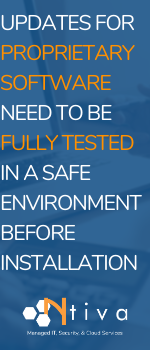There’s no denying that automatic updating is a handy tool, but it’s not always the way to go. In some cases, manual updating is the safer solution, and all responsible Managed IT Service Providers understand that “automatic” doesn’t always mean “better.”
If you’re the type of person to turn on automatic updates for all of your devices and never think twice about it, you might find this next topic a complete waste of time. But the fact of the matter is that you should be thinking twice about it, especially when it comes to business-critical software that keeps company operations running smoothly.
There are pros and cons to keeping up with software updates automatically, and the same goes for manual updating. Weighing these pros and cons is the first step in developing the perfect strategy for keeping your system’s vital software up-to-date and running without a hitch.
What Are Automatic Software Updates?

An automatic software update is a patch, correction, or change made to software that is distributed through an automated push by the developer.
Sometimes IT-related issues can be resolved through a quick chat with your IT help desk, but more often than not, the problem stems from the need for a software update.
No software is 100% perfect. Once it’s been released to the public, the team that developed that software can determine where there’s room for improvement, focus on bug fixes, enhance usability, and add on protection features.
Once a developer has updated a program at the source, the updated version of the software needs to be accessed by the users. And the easiest way for that to happen is through the automatic updating process.
Some programs are designed to update automatically and give the user no choice but to accept this, like Microsoft Windows operating system and Google Chrome. Other software allows this feature to be disabled, but many programs don’t recommend that since updates are usually designed to protect against security problems and user issues.
What Are the Advantages of Automatic Updates?
The main pro of keeping your automatic update functions enabled is that any newly-discovered security or performance issues are, well, automatically updated.
There’s no action required on your part; once a software developer has made a change, you can take advantage of that change right away.
IT solutions vary by industry, but regardless of your field of business, security threats can wreak havoc.
With automatic updates, once a security vulnerability has been addressed by the developer, the problem is fixed and you can go about your day.
Are There Any Disadvantages of Automatic Software Updates?
No matter how great you think automatic updating may be, it’s important to remember that nothing’s perfect. When companies deploy updates that are “buggy” or when a program update hasn’t been properly vetted, it can actually cause more harm than good.
Software Isn't Always Compatible with Automation
A lot of proprietary and/or customized installs need to be fully tested in a safe environment before being installed on every device in an organization’s network. And what a lot of people don’t realize is that automatic updates might not be compatible with every software and they often can’t update firmware or unique file types.
It Creates a False Sense of Security
The biggest downside of automatic updating is that it tends to create a false sense of security, which isn’t ideal in a world where cyber security threats against small businesses are so prevalent. Even the most up-to-date system isn’t immune to breaches, so don’t assume that yours is just because you have automatic updating enabled.
It Can Get in the Way of Productivity
Lastly, updates take time to download and install, and this can cause interruptions in the normal workflow. It’s not always possible to choose the exact time of day or night you want an update to take place, so even if it’s during the prime working hours, you’ll just have to be patient.
Automated Software Updates vs. Manual Software Updates
When weighing automatic vs manual, it’s pretty much impossible to say that one trumps the other. This is because it’s completely situation-based; automatic updating is better for certain scenarios, but for others, it’s wiser to go manual.
Here’s a breakdown of when to use which:
Automatic updates are best for:
- Essential security fixes that address system vulnerabilities
- Operating system updates that have been thoroughly tested/vetted by vendors
- Updates that can easily be reverted back if anything goes wrong
Manual updates are best for:
- Unreliable updates for things like firmware and network switches
- Updates for systems and servers that are essential for business operations (it’s a major problem if a critical server crashes in the middle of the workday)
The key is to take advantage of automatic updates that pose no risk while also using manual practices when necessary.
What is the Solution to Automatic Updates?
We’re not going to sit here and tell you that you should be manually updating all aspects of your organization’s system. We will, however, tell you that it’s important to strike that perfect balance between automation and taking manual action.
Reliable IT service providers like Ntiva test updates fully in a separate virtual environment before installing them over a network. By hiring an MSP or turning to a co-managed IT solution, you won’t have to worry about developing an updating strategy on your own.
If you're interested in taking these troublesome routine tasks off the plate of your current IT team, reach out to us!




